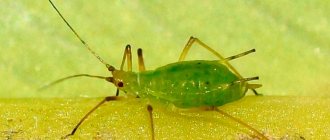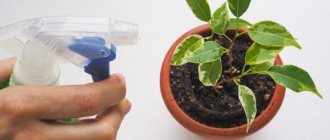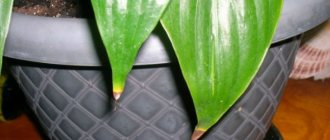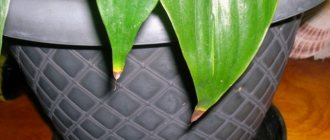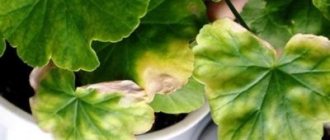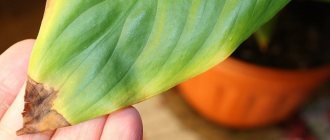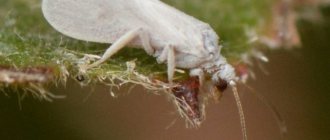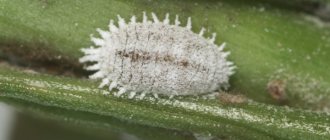Reasons for the appearance of a sticky coating on house flowers
If a sticky coating appears on the leaves of indoor plants, then you need to urgently look for the cause and eliminate it. In 90-94% of cases, stickiness on indoor flowers appears from various pests living on flower crops. The product of their vital activity covers the foliage in such a thick layer that an unpleasant substance begins to drip from the flowers.
A layer of sticky plaque, as well as white or brown spots on the green flowers, will “tell” about the presence of pests.
Where does the sticky layer come from:
- Sticky secretions and pinpoint marks are left by aphids and mealybugs;
- Scale insects leave growths and warts on the trunks of indoor plants;
- The stickiness on the underside of the leaf blades is caused by whitefly larvae;
- A sticky, thick white coating is created by spider mites.
Scale insect - a dangerous insect
If the thyroid gland is active, then expect trouble. This pest is difficult to detect immediately.
How to destroy scale insects on indoor flowers
Useful advice from an agronomist
I am not a blogger from the twelfth floor, but a practitioner who has connected my entire life with my mother-nurse - the EARTH. I have something to tell you about the earth and everything growing on it
Ask a Question
Among the many pests of indoor flowers, a special place should be given to the scale insect, this inconspicuous plant killer that sucks the juice from the plant. She does not fly, does not crawl, and therefore we sometimes notice her very late. Only when we are already trying to understand why our pets are oppressed, do not grow, and sometimes simply die. How to often inspect the flowers in the house, find this pest, and how to deal with them - in this film. Look at it carefully
What do scale insects look like?
The adult insect is covered with a hard brown shield, under which hordes of eggs are hidden. The female pests bite tightly into the leaf and use their proboscis to draw juices out of the plant.
If the females sit motionless, then the males move from place to place, infecting the seedlings of the home greenhouse bush by bush. They themselves do not eat foliage, but they can move around and infect.
The scale leaves a sweet sticky trail or honeydew without a break to rest. Females are so fertile that they bear offspring 5-6 times throughout the year.
The tenacious insect does not rest even in winter. Colonies of the pest grow so quickly and abundantly that they can take over the entire home greenhouse. Even poisonous flowers are not spared.
How do they get into the house? They can fly through windows with the wind and get into a house with a plant that was purchased at a flower shop.
These pests are omnivores. They are ready to eat: palm trees, citrus fruits, bromeliads. Females happily live on orchids, lemons, ficuses, ivy, crassula, and cacti.
Features of growth
Petunia is unpretentious. The stem of the plant can be from 10 cm to 1 meter. The stem is erect or densely branched, creeping. The leaves are arranged in alternate order or opposite.
The flower itself is light-loving and heat-loving. It grows well in sunny places, is also drought-resistant, and can go without water for a long time, but it should be noted that this flower does not tolerate stagnation of water, that is, it should not be filled with water.
The most common type of planting is through seedlings or into the ground . It should be noted that if planted through the ground, then in this case a not lush shrub will grow. It is better to choose the planting time from the end of January or mid-March; these features are indicated on the packet of seeds. Special cups are prepared for seedlings; holes must be made in them at the bottom for better water flow.
Mealybug
A white sticky coating, similar to a cobweb, is a sign of the formation of a clutch of mealybug eggs. The parasite lays a large number of eggs under the web.
What does an insect look like?
An adult female, no more than 5 mm long, comes in pink, white, and beige colors. Along its body there are small bristles covered with a white powdery coating.
To immediately notice that something is wrong, pay attention to whether sticky drops appear on the plant. This is the first stage of infection of a green pet.
Next, a sticky white coating forms, resembling pieces of cotton wool. At the last stage of infection, a change in the shape of flowers and leaves occurs. The leaves take on a marbled color and are covered with spots of red or yellow.
When leaf blades change, photosynthesis is disrupted and the plant dies.
The reasons for the appearance of this pest: dry air, temperatures above plus 20ºС, unfavorable conditions for development. Most often, the pest multiplies in winter, when there is a lack of lighting, dry air, and excessive watering, leading to stagnation of water in the soil and pan.
The most dangerous phenomenon in winter is waterlogging. Too much water in the soil leads to rotting of the roots, the appearance of parasites and microbes. When watering, you should pay attention not to the interval between waterings, but to the condition of the roots.
Prevention
If you do not follow agricultural technology and optimal conditions for keeping Saintpaulia: humidity, temperature, light, preventive measures , then there is a risk of getting a mealybug in your collection.
The mealybug spreads at low humidity and temperatures of 24-27 degrees, mainly in winter.
If you ignore the first signs of infection: sticky drops, white coating, yellowing of leaves, then the scale of the disaster will become a serious test. To minimize the danger, you must:
- comply with temperature, light and humidity requirements;
- do not place saintpaulias close to each other;
- keep the violet clean - wash the plants at least once every 2 months in the shower with 40-45 degree water;
- inspect each Saintpaulia for the presence of white plaque and sugar drops at least once a week;
- carry out annual treatment with broad-spectrum pesticides;
- Place the purchased plant in quarantine for 2-3 weeks, having previously treated the flower against pests.
Advice! If infection could not be avoided, then in order to prevent the mealybug from spreading to other Saintpaulias, it is necessary first of all to isolate it from other plants. Carry out preventive treatment of all nearby violets and surfaces.
What to do if the leaves become sticky
What measures to take if a sticky coating appears on an indoor flower? First of all, you need to inspect the seedling. Sweetish drops may also appear on healthy plants during flowering. This natural function is needed to attract pollinating insects. After flowering ends, the drops will disappear.
Gum disease can affect citrus and other flower crops, even without pests appearing on them.
If an amber sticky liquid appears on the foliage and bark of citrus fruits, the cause may be excess nitrogen, damage to the trunk, fungi, or improper planting.
Sticky droplets can appear on branches, buds and leaves of other indoor plants. You just need to change the fertilizing and maintenance conditions, and treat the fungus with fungicides.
But if scale insects or other pests have taken a fancy to your plant, then you need to urgently take action.
Controlling sticky pests
Any diseased plant should be sent away from the greenhouse, and other crops should be examined. Infected seedlings should also be quarantined.
Treatment of an infected bush:
- Wash the flower with hot soapy water, dissolving a piece of laundry soap in it.
- After washing off the honeydew and some of the insects, rinse the window and windowsill, and wash the curtains. Parasite larvae may also remain here.
- Buy “green” soap at a flower shop, beat it into a thick foam, and carefully wipe the leaves with a sponge soaked in a soap solution.
- There is no need to wash off the soap right away. After 15 minutes, rinse the plant under a hot shower, then dry in a warm place.
What to do with brown scales
What to do with adult female scale insects? They look like brown scales or bumps, settling on the trunk in the most inaccessible place.
How to remove pests:
- First you need to cut off all diseased leaves and branches of the seedling;
- Use a cotton swab dipped in alcohol to remove any insects that can be reached;
- Pour 10 ml of alcohol into the solution (beat 20 g of laundry soap in 1 liter of water);
- Use a cotton pad to distribute the prepared solution over the scales;
- Next, rinse the leaves with the solution, top and bottom, especially along the veins;
- This treatment of the plant must be carried out 3 times every 10 days. After this treatment, the scale insect should disappear.
Important! Insects should not be removed by hand. Damage the scales and the population will multiply at lightning speed.
General information
Powdery mildew is a fungal disease that develops very quickly and can infect all surrounding vegetation in a short period of time. A whitish coating forms on the leaves, which looks like powdered sugar or dust.
The disease quickly spreads from the foliage to other parts of the flower: shoots, trunk and even roots. The leaves begin to rapidly turn yellow, dry out and fall off. Young foliage appears already deformed. If treatment is not started in a timely manner, the plant may die.
Many gardeners consider this problem not so dangerous, but this opinion is wrong. In fact, the white coating is a parasitic mycelium from which pests emerge. They penetrate the plant cells and drink the juice from it. As a result, the flower’s foliage begins to atrophy and it simply dies.
If you try to look at the leaves through a magnifying glass, you can clearly see small sores on them. The fungus practically eats away the surface of the leaf, robbing it of vital juices and nutrients.
In addition, the disease interferes with the natural process of photosynthesis. This is why it is so important to start treatment immediately. If you start this problem, the petunia will simply die.
Chemicals
After treating with a soap solution, you can finish the fight with the help of chemicals. They act more effectively in May-July, when the females are still without protective shields. The best preparations for spraying: Fitoverm, Aktara (KS, VOP).
Processing stages
- After spraying with insecticide, the flower should be covered with a bag and left for 40 minutes.
- Then rinse the seedling in the shower to remove the chemical and dead individuals.
- After 2 weeks, repeat spraying to destroy hidden beetles.
- Check all indoor flowers regularly using a magnifying glass.
Efficiency of Aktara
"Aktara" is a new generation insecticide. It has characteristics such as high efficiency and versatility in use.
This drug is toxic, so all precautions must be taken when using it. It is especially dangerous to inhale the vapors of this product. While working, you must wear gloves, a protective mask and goggles.
If home vegetation is attacked by parasites, then “Aktara” will help cope with them.
"Aktara" is a fast-acting insecticide with enteric contact action. The product is available in granules and suspensions. Its substances have a detrimental effect on many insects.
Advantages of "Aktara":
- It has a high degree of absorption, so the drug is capable of destroying more than 100 types of pests;
- The impact on pests is rapid. After an hour, you can notice the death of the parasites;
- Plants can be treated at any time and in any weather;
- The drug can act for 1 to 2 months;
- Without accumulation effect, therefore does not harm crops.
Disadvantages of Aktara:
- Harmful to bees, wasps, hornets;
- It is not recommended to store in a diluted state.
Dilute the drug only according to the instructions. Treat only trunks, leaves and roots, avoiding flowers and ovaries. After treatment, the flowers should stand for 24 hours, preferably under a bag. Dilute the product only with warm water.
If pests have dug into the root zone, then watering with Aktara will help protect the entire plant. The root system will begin to promote the drug substances throughout all cells of the culture, and the parasites will quickly become saturated with poison.
“Aktara” will destroy their digestive tract, as a result the nerve endings of the parasite will be paralyzed, so the insect will no longer want to suck the juices from the plant. Without food it will soon die.
Why sticky plaque is dangerous for indoor plants
If the leaves become sticky, take immediate action. First of all, armed with a magnifying glass, inspect the plant. Perhaps there are dangerous parasites among the foliage.
Let's look at leaf diseases and treatment of different flowers.
Sticky leaves on an orchid
Owners of orchids strictly monitor the health of their pets, but these luxurious flowers are also attacked by pests. Sticky leaves on an orchid may indicate a mealybug infestation.
To prevent the orchid from being affected by scale insects, it is necessary to perform the following actions:
- Inspect flowers frequently;
- Create favorable conditions, that is, illuminate and humidify the air in winter by placing a bowl of water next to the flower;
- Wipe the orchid leaves with a solution of laundry soap;
- For transplantation, buy an uncontaminated substrate or disinfect it after purchasing it at home;
- Dry the homemade bark for 15 minutes in the oven at 60 ℃.
- Cut off affected leaves and flowers.
Often sticky drops of nectar appear on the leaves of the orchid. This is a natural process, the flower seems to “sweat”. Drops are simply washed off with water.
Other reasons for the appearance of stickiness on leaf blades: excessive watering, excessive fertilizing, infection with scale insects or aphids.
Phalaenopsis orchid
Flowers of the Phanelopsis variety are distinguished by a variety of colors, and therefore are in a special place among gardeners. In the process of growing phalaenopsis, many problems also arise that cause anxiety to the owner. One such problem is sticky spots on leaves.
Stickiness is a distress signal, or it may be a natural process. As a flower grows, moisture moves through the plant, forming nectar. Thus, the leaves of the phalaenopsis are covered with a sweet substance or nectar.
Droplets on leaves attract pollinators or ants. In nature, ants are excellent at destroying aphids, so the sticky coating is useful for this crop.
Sweet nectar also serves as a trap for harmful microorganisms. Getting entangled in the sweet substance, they simply die.
Reasons for the appearance of nectar:
- Excessive watering;
- The accumulation of moisture in the pan or in the substrate causes the plant to emit evaporation;
- Low temperature;
- Excess fertilizing with phosphorus, potassium and nitrogen.
Oversaturation with fertilizers and moisture leads to the release of excess sugars. Even this seemingly natural process can have a detrimental effect on the health of the flower. Dark spots appear on the leaves, which interfere with photosynthesis. To save a blooming pet, it is necessary to completely replace the substrate, otherwise the death of the flower rosette and the flower stalks themselves will occur.
The nectar that appears on the leaves of the flowers can be wiped off with a wet sponge and put the flower in the shower. It doesn’t hurt to take a good look at each leaf under a magnifying glass so as not to miss pests.
Ficus
If this large indoor flower gets sick, sticky leaves will be the first symptom of the disease. Stickiness just confirms the presence of pests attacking the flower crop.
Let's consider the reasons for the appearance of a sticky substance on the ficus. Ficus can be affected by spider mites. If the leaf blades are covered with white dots, and the rest of the ficus is covered with a thin cobweb, then start fighting spider mites. Spider mites develop quickly in dry air and high temperatures.
But thrips can also cause sticky leaf blades. These pests are very similar in appearance to small flies. They feed on plant sap and live in large colonies. By sucking the sap of a plant, they can destroy it.
Scale insects and aphids can also attack ficus plants. If your ficus has sticky leaves, don't rely on luck. Without eliminating pests, the problem will not be solved.
Drugs such as Actellik, Vermitec and Flumite will help get rid of spider mites. To completely destroy the insect, 3 treatments will be needed at intervals of 5-7 days. Thrips are killed by the same insecticides as spider mites.
The ficus benjamina also produces sticky leaves. If there are few insects, then it is enough to wipe the ficus leaves with a sponge dipped in a soap solution.
Large colonies and scale insect larvae die after treatment with an insecticide, for example, Actra. It will be necessary to treat the diseased seedling three times, allowing an interval of 7 days between treatments. In order for the pests to die, after treatment the plant must be covered with a bag and kept under cover for a day.
Important! After destroying the parasites, the Ficus Benjamin needs to create better conditions: increase lighting, raise the temperature and humidity, establish the correct watering regime so that the pests do not return.
Begonia
Begonia is a favorite flower of many gardeners. Begonias and sticky leaves don't seem to go together. But it can also be attacked by the same pests.
Begonia can be destroyed by pests such as thrips, scale insects, and spider mites. The appearance of pests can be noticed by changes in the stem of the plant. It begins to shrink and age quickly. At the same time, the state of the begonia does not confirm the presence of parasites: the leaf is shiny, the color is lush.
Thrips are the most dangerous for begonias. To get rid of this parasite, many gardeners cut off clean, uninfected shoots from the plant, wash it with water, root it and plant it in a clean pot. The mother bush can also be saved by treating it with Fitoverm.
Anthurium
A blooming anthurium brings many pleasant moments to its owner. It blooms with incredibly attractive flowers of pink, white, bright red, and purple.
Often this flower is attacked by various parasites, affecting the beautiful leaves. White sticky coating, dark or light spots, cobwebs under the leaves - all this indicates that the flower is damaged by pests.
If you wash the tops of the foliage and under the leaves with a soapy solution, most of the insects will be removed. If the disease is advanced, more stringent measures will have to be taken.
The plant can be saved from aphids using a folk remedy: leave 15 grams of chopped onion or 6 grams of dry scales in 1 liter of water for 5 hours. Spraying is carried out three times, with an interval of 5 days.
In advanced cases, you will have to treat with Fitoverm, Actellik, Karbofos, Biotlin. Treatment with Fitoverm will save you from thrips and spider mites.
Chinese rose
The lushly blooming Chinese rose is a real decoration of a home greenhouse. Flower growers treasure this beautiful flower. One of the unpleasant aspects of breeding is the appearance of sticky leaves on Chinese roses.
There is no need to despair; it is worth understanding the reasons for the stickiness of the leaves. A careful inspection of the flower crop will help eliminate or detect pests. A sticky coating is created by aphids, scale insects, and whiteflies.
If parasites are found, then they must be combated with the help of chemicals. You will have to treat both the plant itself and the soil.
If no parasites are found, but there are still sticky drops, it’s worth looking into this phenomenon. Often, especially in hot weather, small sticky droplets appear on the back of Chinese rose leaves. They usually appear after watering during hot periods. The plant seems to “sweat”. This is a normal natural phenomenon.
The unpleasant thing is that drops of nectar drip and stain everything around. How to get rid of this phenomenon? You can get rid of it if you give the plant “bathing” under a hot shower more often. It has been noticed that the rose loves water treatments!
It's worse when pests are discovered. If brown tubercles are found on the trunks, then these are sucking insects - scale insects and false scale insects draw sap from the plant.
The leaf under the scale is lighter than the rest of the leaf blade. This sign can also help identify the parasite.
Mealybug - also leaves stickiness and spoils the plant. It looks like a fluffy, round insect, and when crushed it releases an orange liquid.
Thanks to the waxy coating, the bug is protected from the effects of contact drugs. It must be combated with intestinal drugs.
Treatment with Aktara will help get rid of these pests. Dissolve 4 g of the product in 5 liters of water, spray the flower, and then spill the soil with this solution: 1 g per 10 liters. Carry out the treatment 4 times with an interval of 7-10 days.
If the plant is not neglected, it will require treatment (after 1-2 days) with acarin, agravertine, and fitoverm.
Citrus
Growing citrus fruits is not just fashion and delicious fruits, but also purifies the air in the apartment.
Much to the regret of many flower growers, indoor lemons are plagued by harmful insects, whose activity causes a sticky coating to appear on the trunk and leaves.
Sometimes indoor lemons have sweet droplets on the leaves, as if syrup had been sprinkled on it. One of the reasons is considered to be excessive watering. Lemon should not be watered so much that the soil is always moist.
If watering is adjusted, and stickiness appears on the lemon leaves again, then look for scale insects. This insect can blend so well with the bark of a lemon tree that you won’t immediately notice it.
Signs of scale insect infestation:
- dry spots of brown color;
- sticky coating on the trunk and foliage of a tree.
Scale insects most often attack weakened young trees. It is necessary to feed citrus seedlings with complex fertilizers 4 times a year.
If you do not get rid of this insect, it will quickly increase its habitat area. But spraying with chemicals can cause the fruits of the current and next harvest to become poisonous and cannot be eaten.
Therefore, insects must be detected as early as possible and sprayed with less aggressive means:
- Dilute 10 ml of 70% alcohol and 15 ml of laundry soap in 1 liter of water;
- Protect the soil from contact with the solution;
- Apply the product directly to the affected areas.
If the scale insects have not disappeared, then every 3 days you will have to spray with “Confidor” or “Aktar” until the pest completely disappears. When spraying, pay attention to the root zone and the underside of the leaf blades.
The harvest of this year, as well as the next season, cannot be eaten.
Warmth and high humidity can attract whiteflies. It is signaled by a white coating on the foliage, similar to mold. Wipe the leaves with a sponge dipped in soapy water.
Spraying with a sweet solution works well. For 1 glass of water you will need 2 tbsp. spoons of sugar. A week after the sweet spray, put the lemon in the shower.
Try to get rid of mealybugs by rubbing the stems and leaves with garlic infusion: crush 6-7 cloves of garlic and pour 0.5 liters of hot water, leave for 4 hours.
Mandarins can also be attacked by sucking insects. The treatment is the same as for lemon. And it is best to carry out preventive measures: often examine the trees under a magnifying glass, arrange a hot shower, and create favorable conditions for growth.
Calathea
The calathea flower attracts attention with its beautiful large leaves. But sometimes sticky streams appear under the leaves. This is a warning sign. Perhaps the flower was attacked by dangerous pests: scale insects or spider mites.
Due to the fact that the flower has large leaves, you can limit yourself to wiping them with a sponge dipped in a solution of laundry soap.
The most dangerous pest for calathea is the spider mite. It can be detected by a dense white web and the appearance of white spots on the leaves.
It attacks calathea if the air in the room is too dry. Therefore, it is necessary to achieve normal air humidity. Place a container of water near the flower, arrange a shower, and wipe the leaves on both sides more often.
Preventive measures
The best way to combat powdery mildew is to prevent the disease. Of course, to avoid problems, you can plant varieties of petunias that are resistant to fungal diseases. But if you do not adhere to basic rules in caring for plants, then even plants with genetic immunity will not resist diseases. Therefore, first of all, try to provide the plants with proper care:
- Water your petunias only after you are sure the soil ball is dry enough, but not too dry. Use warm, settled water to water your plants.
- Plantings must be periodically thinned, first removing flaccid shoots (what to do if petunia withers and why does this happen?).
- When feeding petunias, follow the proportions and do not get carried away with nitrogen-based fertilizers.
- Give preference to potassium-phosphorus mixtures, they promote the development of immunity in petunias.
- Inspect your petunia plantings daily.
- Periodically spray the plants with a biofungicide. You can use “Fitosporin” or “Pseudobacterin”.
By following these simple rules, you can give your plants a long life and yourself the joy of the positive results of your work.
It is better to prevent a disease than to fight it later. Do not forget about the prevention of plant diseases, and then you will not have to use fungicidal preparations on your plots. Following agricultural practices will help, if not completely avoid diseases, then certainly reduce their likelihood by 90%.
Experienced gardeners know that most diseases develop on plants due to insufficient care . Be attentive to your plantings, devote very little time to inspecting the plants daily, and they will thank you with lush flowers, becoming a true decoration of both flower beds and balconies.
